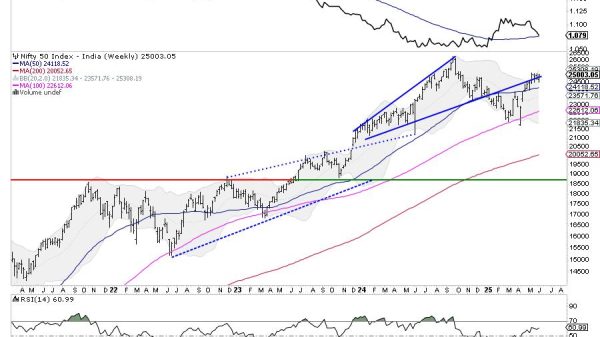Channeling Stocks: Strategies for Traders and Investors
Channelling stocks offers a strategic approach for those looking to maximize their returns. This technique, rooted in technical analysis, revolves around identifying and channeling stocks and commodities. It harnesses the power of chart patterns to predict future price movements.
The Price Channel is an indicator that frames the evolution of prices by two bands. These bonds represent the highest and lowest sliding over a period chosen by the user. Thus, the indicator frames the evolution of prices between the support and resistance levels.
Key takeaways
Channeling stock comprises channeling indicators to frame price evolution using the highest and lowest points over a selected period. Channeling involves stocks moving within parallel trendlines, forming ascending, descending, or horizontal channels. Channels consist of two parallel trend lines connecting swing highs and lows. Channels vary in direction and market trend representation, including downtrends and horizontal channels. Channeling stocks guide entry and exit trades and are more effective in combination with tools like MACD.Channeling stocks – definition
Channeling stocks are stocks in a trading range with prices linked by parallel trendlines. These lines bound the price lows and highs. They form the area in which the asset is channeling.
The upper line represents resistance. The lower one is the support line.
Trading ranges and channeling stocks represent the price action, as stocks trend less than half of the time.
Suppose the stock breaks out of a trading range. It is affected by the channel’s duration, its width, and the strength of the breakout. Trading channelling stocks means selling resistance and buying support while waiting for a larger move to trade.
How to identify channelling stock?
The movement of channeling stock is limited. And it’s bound by a precise trading range. You will spot resistance above and support below the stock. Sellers are waiting for resistance.
By selling at higher prices it prevents the stock from new highs. Buyers wait for support. And they prevent the stock from decreasing by purchasing at a lower price.
This leaves the stock with horizontal price action rather than an uptrend or downtrend. Regarding the trading range, it can be narrow or wide. And is typically resolved with a high-volume thrust to new relative highs or lows.
Channel Characteristics
In the realm of channelling, understanding the characteristics of a channel is fundamental. A channel typically consists of two parallel trend lines: the upper trend line and the lower trend line.
These lines connect the respective swing highs and lows of a stock, commodity, or ETF over a period of time. The space between these parallel trendlines forms the channel where the price action occurs.
When the price touches the upper trendline, it often encounters resistance, indicating a potential reversal. Conversely, the lower trendline acts as a support level, where prices may bounce back after touching or approaching this line.
Types of Channels in Stocks Trading
Channels vary depending on their direction and the market trend they represent. Ascending channels, where the parallel trend lines slant upwards, suggest an ongoing uptrend.
It offers traders opportunities for entering a long position. In descending channels, the trendlines angle downwards, indicating a downtrend, and can signal opportunities for shorting the stock. Horizontal channels, or trading ranges, occur when the trendlines are horizontal.
They show that the stock is moving sideways over a period of time without a clear uptrend or downtrend.
Buying or Shorting the Channeling Stock
When it comes to trading channels, the strategies for buying or shorting are clear-cut. In an ascending channel, traders often consider taking a long position.
That’s when the price dips towards the lower trendline, a support level. They then look to sell signals or take profits at the top of the channel, near the upper trendline.
On the other hand, shorting is more common in descending channels. Here, traders wait for the price to rise to the upper trendline before entering a short position. And then aim to cover or take profits near the lower trendline.
Additionally, when the price breaks through the upper or lower trendline, it signals a significant shift in trajectory. It prompts traders to adjust their positions accordingly.
Identifying Channels for Effective Trading
The key to channelling lies in correctly identifying channels. This involves a close examination of trendline connections and the patterns they form.
Channeling stocks not only guides traders on where to enter and exit trades but also enhances other trading strategies.
Incorporating tools like the Moving Average Convergence Divergence (MACD) and stochastic crossover can increase the accuracy of trading signals. Volume analysis is also crucial. It can validate the strength of a channel breakout, like the one observed in Hyatt Hotels Corporation stock.
Channeling stock Risk Control
Effective channelling involves stringent risk control measures. This includes setting stop-loss orders to minimize losses and identifying take-profit levels for securing gains. Channeling helps in determining these levels, which are crucial for money management.
Trading Channels Across Different Time Frames
Channeling is effective across various time frames, whether you’re a day trader or a long-term investor. Time frame analysis can reveal different trading opportunities, from short-term profit-taking to long-term investment strategies.
Types of Channels and Their Trading Implications
There are various types of channels that traders can utilize. Ascending and descending channels, which signal uptrends and downtrends, are known as trend channels. Horizontal channels, on the other hand, indicate periods of consolidation and offer opportunities for range trading.
Practical Application of Channeling Strategies
To unlock the potential of channelling stocks, traders should practice identifying channels and acting on their signals. This includes buying at the lower trendline of an ascending channel. Or shorting at the upper trendline of a descending channel. In narrower channels, traders need to adjust their strategies, as these often signal a shift in market dynamics.
Maximizing Profit Potential with Channeling
The profit potential in channeling lies in recognizing and acting on channel breakouts and breakdowns. A breakout above an ascending channel or a breakdown below a descending channel can signal significant market movements. This could be a great opportunity for profit.
Conclusion
Channeling is a dynamic and versatile tool in the arsenal of traders and investors. By mastering the art of identifying and trading channels, traders can significantly enhance their trading performance and unlock the potential for substantial profits.
The post Channeling Stocks: Strategies for Traders and Investors appeared first on FinanceBrokerage.

























